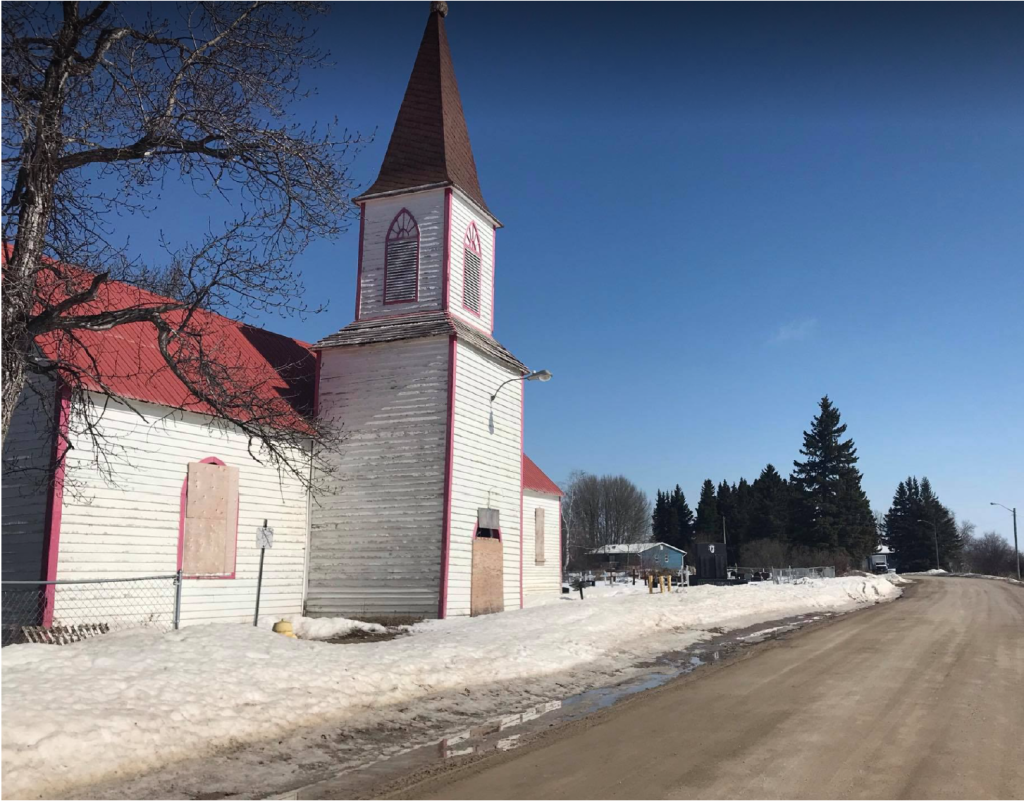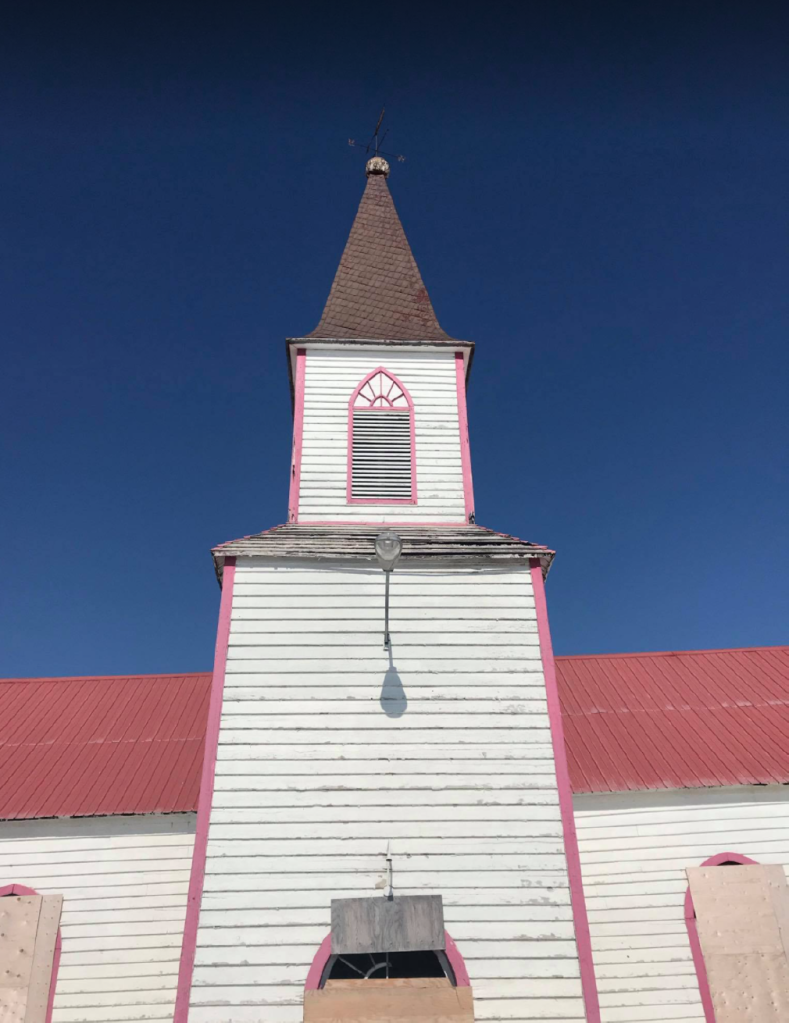This article is part of the Hidden Canada series – a collaboration between ACO NextGen and students from the University of Toronto. In their seminar on Canadian architecture and landscapes, students were asked to focus on little-studied aspects of the built environment in Canada, or to approach well-known places from a fresh perspective. These articles are the result of their exploration.
In the year of 1860, St. Thomas Church floated away from its original place.
Since it overlooks the Moose River, it was only a matter of time before the church faced the annual spring flooding. High flood waters carried the building through the community of Moose Factory, Ontario, all the way to the middle of a field in front of the old Hudson’s Bay Company building, just over two kilometres down the road. While the water was still high, members of the community hauled the church back and anchored to its original location until the flood waters subsided.
The church also survived a fire, where it was nearly burnt to the ground as the building filled with smoke. Yet, year after year, the church has remained. Rumour has it that there are “plugs” in the floor, designed to let the water seep out in case of another flood.

Despite all the building’s resilience, as of 2021, the St. Thomas Parish Hall is not able to be used. To combat this, the Moose River Heritage and Hospitality Association (MRHHA) are working diligently to restore the St. Thomas Parish Hall to its original condition, in hopes of contributing to the larger project of preserving the “post-European contact” heritage of Moose Factory.
This mysterious church, that has survived the harsh winter climate, is surprisingly not built out of stone, but rather timber and tin. The St. Thomas Parish Hall is a very basic Timber Gothic Revival church commissioned by Bishop John Horden and built by Hudson’s Bay company employees from 1864-1865. The exterior of the church is painted stark white with horizontally aligned siding, foregoing the verticality characteristic of Gothic Revival. It is constructed out of local resources like hand-whip-sawn timber and adzed squared logs.
The red roof is pitched, although slightly less than the standard “ecclesiology-correct” church architecture design. The spire was once wrapped in a shiny tin, resembling silver on a sunny morning. Now, it is quite rusted. The church prominently features lancet windows – the eastern stained-glass window was sent from England in sections and the frame was locally made. The other windows were preserved from Horden Hall, the old Indian Residential School nearby. Bishop John Horden never referred to the church as being of the Gothic Revival mode, but he did frequently reference the “Englishness” of the design.

The St. Thomas Parish Hall is deeply important to the community of Moose Factory. The back of the church holds a graveyard full of generations of Omushkego peoples. That alone, validates the need to restore the church. The church also represents the complex history of the arrival of Christian missionaries on Indigenous land.
The church acted as a loved community gathering centre, where funerals, Sunday school, baptisms and services took place. In an effort to translate the written word of Christianity into Cree and Inuit languages, Bishop John Horden, Thomas Vincent, and Edward Peck – the earliest leaders of the diocese – also worked to develop Cree and Inuit syllabics.
But the church also serves as a symbol of colonial settling and injustices enacted against Indigenous Peoples. St. Thomas’s relationship with the Hudson’s Bay Company represents the catalyst for the development of an established settlement on Moose Factory Island. Maintaining the stained-glass windows is important to honour the victims of the residential school legacy. Horden Hall was the Indian Residential School in Moose Factory that ran from 1906 to 1976. In the wake of the harm done by the residential school system, this painful history should not be forgotten.

And so, the St. Thomas Parish Hall is in the process of being claimed as an Ontario Historic Site. This process would be much quicker if the St. Thomas Parish Hall was on Moose Factory Island, or in the jurisdiction of Moose Cree First Nation. According to the Ontario Heritage Act, any First Nations band or municipality can claim a location as an Ontario Heritage Site. However, St. Thomas rests on “Unorganized Northern Territory”. The territory is not designated as Moose Cree First Nation, nor can the province use it. In the early days of Canada, Ontario commissioners established Treaty agreements with First Nations communities across the province in an attempt to acquire more land from the Indigenous Peoples there. According to Treaty 9, the church is on Omushkego land. However, this is not recognized by the Canadian government. So, even though the St. Thomas is less than a kilometre away from Moose Cree First Nation, it is unable to be directly named a heritage site by the First Nation.
Ultimately, this problem is a reflection of the reality for Indigenous Peoples living under the extremely out-dated and problematic Indian Act.
In 2021, heritage is a convoluted topic. The MRHHA seeks to preserve the complex heritage of Moose Factory in their “More than 350” celebration in 2023, but is that the heritage that the community wants to have? In a time where conversations of decolonization, the Truth and Reconciliation Commission of Canada, and the ongoing battle for sovereignty are prevalent, it begs the question of what the preservation of the St. Thomas Parish Hall reflects. Is it Canadian nationalism? Or the reflection of colonization? Or is it the reflection of Indigenous persistence? These questions do not have any precise answers, and unanimous consensus is difficult to gain.
Despite the convoluted issues of land claim and sovereignty – or perhaps because of it – the MRHHA is still working to have the St. Thomas Parish Hall designated as an Ontario Heritage Site. They hope to have the church repaired, revitalized, and most importantly, to pay homage to the significance it has in the community. With the major questions surrounding heritage and reconciliation, it is most important to remember that there are generations of Ancestors buried in that graveyard and it would do them a great service to repair and protect their beloved place of worship.
This article was originally published by ACO NextGen on June 1, 2021; reprinted with permission.


